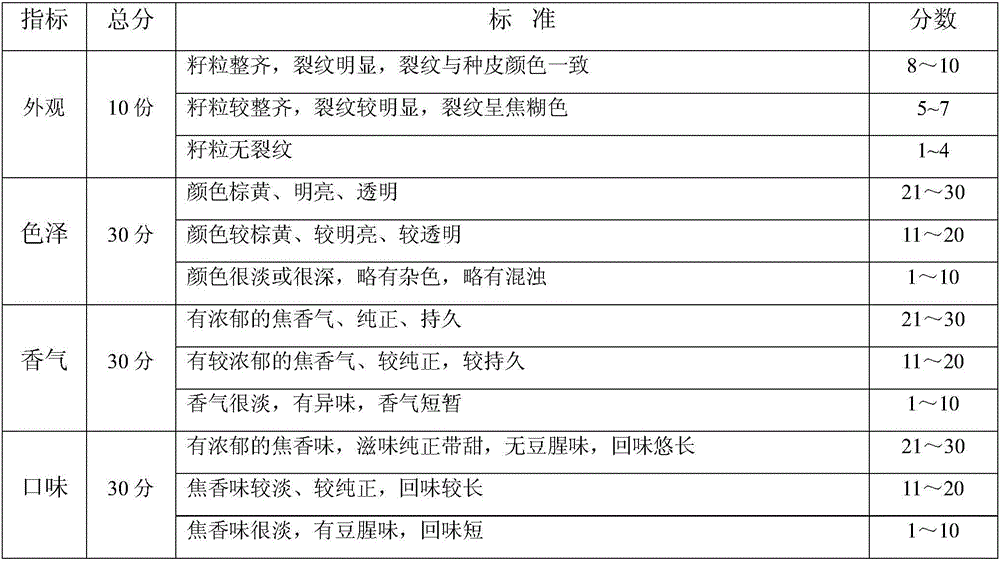Processing method for improving quality of glycine soja tea
The technology of a wild soybean and a processing method is applied in the field of tea product processing, and can solve the problems such as the destruction of soybean nutrients, low medicinal or health value, and long processing time, and achieve the effects of improving quality, shortening processing time, and low processing cost.
- Summary
- Abstract
- Description
- Claims
- Application Information
AI Technical Summary
Problems solved by technology
Method used
Image
Examples
Embodiment 1
[0038] A processing method for improving the quality of wild soybean tea, comprising the following steps: placing wild soybean grains harvested in the same year in hot water (>95°C) three times the weight, soaking for 4 hours, stirring once every 2 hours during this period, and cooling naturally ;Put the soaked wild soybean grains in a germination box, accelerate germination at a constant temperature of 25°C for 30 hours until the bud length is 6mm, during this period, pour water every 5 hours for 30 seconds; place the accelerated wild soybean grains in a blast drying box , dry at 60°C for 28 hours until the water content of the grains is below 8%; place the dried wild soybean grains in an automatic roaster and bake at 140°C for 25 minutes until the skin of the grains cracks; place the roasted wild soybean grains in a dry In a room (the relative water content of the air is less than 15%), after cooling to room temperature, weigh, and pack and seal with aluminum foil bags.
Embodiment 2
[0040] A processing method for improving the quality of wild soybean tea, comprising the following steps: placing the wild soybean grains harvested in the current year in hot water (>95°C) three times the weight, soaking for 3 hours, and stirring once every 1.5 hours during this period, and naturally Cooling; put the soaked wild soybean grains in a germination box, accelerate germination at a constant temperature of 25°C for 24 hours until the bud length is 4mm, during this period, water once every 4 hours, and the watering time is 30s; place the wild soybean grains after germination in a blast drying box inside, dry at 70°C for 24 hours until the moisture content of the grain is 6%; place the dried wild soybean grains in an automatic roaster and bake at 150°C for 20 minutes until the skin of the grains cracks; place the roasted wild soybean grains in a dry In a room (the relative water content of the air is less than 15%), after cooling to room temperature, weigh, and pack and...
Embodiment 3
[0042] A processing method for improving the quality of wild soybean tea, comprising the following steps: placing wild soybean grains harvested in the same year in hot water (>95°C) three times the weight, soaking for 3.5 hours, stirring once every 1.75 hours during the period, Cool naturally; put the soaked wild soybean grains in a germination box, germinate at a constant temperature of 25°C until the bud length is 5mm, during this period, water once every 4.5h, and the watering time is 30s; place the wild soybean grains after germination in blast drying In the box, dry at 65°C until the moisture content of the grain is 6% to 8%; put the dried wild soybean grain in an automatic roaster, bake at 145°C for 22 minutes until the skin of the grain cracks; put the roasted wild soybean grain Place in a dry room (the relative water content of the air is less than 15%), cool to room temperature, weigh, and pack and seal with an aluminum foil bag.
PUM
 Login to View More
Login to View More Abstract
Description
Claims
Application Information
 Login to View More
Login to View More - R&D
- Intellectual Property
- Life Sciences
- Materials
- Tech Scout
- Unparalleled Data Quality
- Higher Quality Content
- 60% Fewer Hallucinations
Browse by: Latest US Patents, China's latest patents, Technical Efficacy Thesaurus, Application Domain, Technology Topic, Popular Technical Reports.
© 2025 PatSnap. All rights reserved.Legal|Privacy policy|Modern Slavery Act Transparency Statement|Sitemap|About US| Contact US: help@patsnap.com



